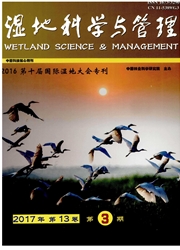

 中文摘要:
中文摘要:
滨海湿地具有重要的生态意义和社会价值。由于社会经济的高速发展,滨海湿地面临着退化和消失的状况。基于红树林种植的滨海湿地恢复模式,是华南沿海传统围垦养殖区湿地恢复的方式之一。对深圳湾滨海湿地恢复工程开展为期1a的监测分析,结果显示:红树植物桐花树Aegiceras corniculatum对人工湿地生境适应性较好,秋茄Kandelia obovata、木榄Bruguiera gymnorrhiza需要在一定人工辅助条件下进行栽培。人工恢复湿地可使遭受污染的4类海水指标大幅改善,溶解氧、COD分别净化为Ⅱ类和Ⅲ类。建议今后尝试增加种植红树植物的种类,使用红树小苗并采取密植,投入适度的人工管理,延长水质处理期,采取多级水循环流程。
 英文摘要:
英文摘要:
Coastal wetland is of significant ecological and social values.The rapid social and economic development has caused extinction and degradation of coastal wetlands.Growing mangrove forests is one of the wetland restoration models of the traditional restoration through reclamation for aquaculture along the southern China coast.Monitoring was carried out for 1 year of Shenzhen Bay Coastal Wetland Restoration Project.Results indicated:Aegiceras corniculatum well adapted to the habitat of artificial wetland,while Kandelia obovata and Bruguiera gymnorrhiza vsn be grown with additional artificial cares.Artificial wetland restoration could significantly improve the quality of polluted water.The parameters of dissolved oxygen(DO) and chemical oxygen demand(COD) were respectively reduced to class II and III.It was suggested that:increase the number of mangrove species,use small plants and large stocking density together with appropriate human management,extend the duration of water treatment,and use multi-scale water cycling flow.
 关于李适宇:
关于李适宇:
 关于陈桂珠:
关于陈桂珠:
 关于管东生:
关于管东生:
 关于彭逸生:
关于彭逸生:
 同期刊论文项目
同期刊论文项目
 同项目期刊论文
同项目期刊论文
 期刊信息
期刊信息
